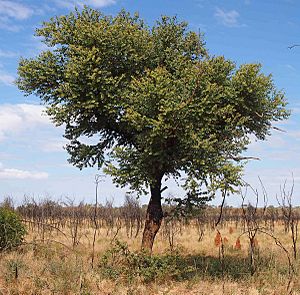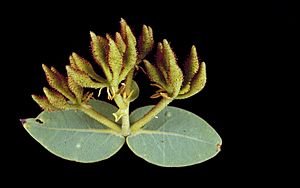Rough-leaved bloodwood facts for kids
Quick facts for kids Rough-leaved bloodwood |
|
|---|---|
 |
|
| Scientific classification | |
| Genus: |
Corymbia
|
| Species: |
setosa
|
| Synonyms | |
The Corymbia setosa, also known as the rough-leaved bloodwood or desert bloodwood, is a small tree found only in north-eastern Australia. This means it is endemic to that area. It has rough, brownish bark that looks like a puzzle on its trunk and branches. Its top leaves are shaped like hearts and grow in pairs. The tree also has white flowers and fruit shaped like urns or small balls.
Contents
What Does the Rough-leaved Bloodwood Look Like?
The Corymbia setosa is usually a small tree, growing up to about 4 meters (13 feet) tall. Sometimes, it can grow as a thick-trunked mallee, which is a type of tree that has many stems from a single root system. This tree has a special woody swelling at its base called a lignotuber, which helps it regrow after fires.
Bark and Leaves
The bark on the trunk and branches is rough and deeply patterned, like a mosaic, and is brownish in color. The tree's top part, called the crown, does not have many leaves. Young plants and new shoots have heart-shaped leaves that are about 38 to 78 mm (1.5 to 3 inches) long and 17 to 33 mm (0.7 to 1.3 inches) wide. These leaves grow directly from the stem in opposite pairs and feel rough.
The main leaves in the tree's crown are also heart-shaped and grow in opposite pairs. They are about 27 to 77 mm (1.1 to 3 inches) long and 10 to 50 mm (0.4 to 2 inches) wide. Both sides of these leaves are a dull light green to grayish-green color.
Flowers and Fruit
The tree's flower buds grow at the ends of its branches. They are arranged in groups of three or seven on a small stalk. Each bud is pear-shaped, about 6 to 12 mm (0.2 to 0.5 inches) long and 5 to 7 mm (0.2 to 0.3 inches) wide. The buds have a beak-like cap that covers the flower inside.
This tree has been seen flowering in June, September, and November. Its flowers are white. After flowering, the tree produces woody fruit. These fruits are shaped like urns or flattened spheres. They are about 11 to 28 mm (0.4 to 1.1 inches) long and 11 to 25 mm (0.4 to 1 inch) wide. The parts that release the seeds are hidden inside the fruit.
Where Does the Rough-leaved Bloodwood Grow?
The Corymbia setosa likes to grow on rocky hills and red sandy plains. You won't find it in very wet tropical areas. It lives across a large part of north-eastern Australia.
You can find it from places like Tennant Creek, Northern Territory and Daly Waters in the Northern Territory. It also grows east into the areas around the Gulf of Carpentaria and on its islands. Its range extends to the Musgrave area of Cape York Peninsula and as far south as Barcaldine in Queensland.
In its natural woodland home, it often grows alongside other trees like Erythrophleum chlorostachys and different types of Eucalyptus. Smaller plants like Grevillea decurrens and Gardenia megasperma grow underneath these trees.
Is the Rough-leaved Bloodwood Protected?
The Queensland Government has looked at the Corymbia setosa. They have decided that it is a species of "least concern" under their Nature Conservation Act 1992. This means it is not currently at risk of disappearing.




